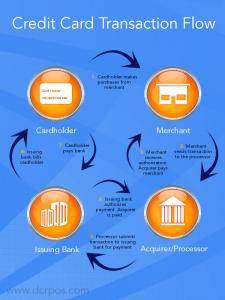
One of the most important and least understood aspects of operating a restaurant, or any small business for that matter, is the use of and costs associated with processing credit cards.
What exactly happens when you swipe a card? What about all those fees on the monthly statement? And all the people who show up saying they can give us a better rate? Before you sign your next processing contract, take a moment to familiarize yourself with what you’re paying for, and how it all works.
First, let’s trace a transaction from start to finish and demystify all this processing. Once the card is swiped, the first stop is the “Gateway,” which is essentially a procedure for credit cards processing over high speed internet to be directed to the proper location. The Gateway sends the information to your “Processor.” These are the people you signed a contract with, such as First Data Merchant Services or Mercury Payment. The Processor redirects the information to the “Interchange,” the big credit card pipeline on the internet, although Interchange can refer to the whole process. From the Interchange, it is directed to the “Issuing Bank,” the institution that gave your customer their credit or debit card. The Issuing Bank will determine if the customer has enough in their account to cover the transaction and send back the proper response. If the transaction is declined, that response is sent back through the pipeline to the Processor and, ultimately, back to you in the form of a slip that will indicate a declined transaction. If approved, the approval code is sent back to the Processor, where the transaction is completed at the store level. The Processor will then deposit the funds into your account, usually within 1-3 days of the approval or batch settlement, i.e., the bulk settling of many transactions. For our usual example, POSitouch, there is an additional component, software referred to as “middleware” which takes the credit card information being gathered by POSitouch and submits it to the Processor as POSitouch does not natively connect directly with most Processors.
Wow, that’s a lot of stops for a single transaction, but, in most cases, an internet authorization only takes a couple of seconds! Hopefully, that clears of some of the how, but let’s turn to the “how much?”, where the fees you see on your merchant statement originate.

Essentially, credit card fees fall into two buckets. The first is the fee charged by the card companies like Visa or American Express. This is referred to as the Interchange Fee, and is non-negotiable as it is a standard rate applied across the credit card industry. This fee is paid to the banks that issue the cards and is based on the type of card (ex: business or consumer), the processing method (ex: swiped, keyed or ecommerce) and business type (ex: restaurant or construction company). Generally this rate is a composite of a percentage fee plus a flat rate. For example, Visa may charge 1.51% plus $.10 for each swiped transaction at a restaurant for a consumer card. That percentage is often called the Assessment portion of the Interchange Fee, and is generally an accumulation of flat fees and percentages based on the above qualifiers, i.e., the card type, type of business and manner of data entry. As we said up front, this fee is non-negotiable, and just part of the cost of doing business with credit and debit card companies.
Where you can start to see some savings is with the second half of your credit card fees, which is called alternately the Markup or the Discount Rate. Those synonymous expressions seem like opposites, but if you’re paying the Markup, you’re also paying the Discount Rate. Both are simply terms used to describe the fee you pay to your processor. There are a couple of types of offerings from processors. The first is the Tiered or Bundled offering, which is when your rate paid to the processor is based on an “Interchange Qualification Matrix,” essentially a formula used to determine which tier your rate falls into. The three tiers are Qualified, Mid-Qualified and Non-Qualified. The rates on Mid- and Non-Qualified tiers are higher than the Qualified tier. What makes this arrangement dicier than the alternative is the fact that a processor may direct more of your transactions to the higher-rate tiers without warning, and suddenly your merchant fees are higher, though your rates have not changed.
This alternative is referred to as Interchange Plus or Pass Through, which removes the tier structure of the above plan. Via Interchange Plus, the processor earns a fixed rate percentage of the transaction. There is also the potential for credits to be levied to your account based on voided or refunded transactions. For example, if I pay a fee to authorize $10, I may receive a credit issued for voiding that authorization, refunding the amount back to the customer. This is generally considered the preferred rate plan because of the flat rate structure and the lack of variability in assigned tiers.
You may see other fees on your bill, so let’s look at the most common. Your processor may levy an application fee when you sign up with them, but this is becoming less and less common as more processors vie for your business. In the early days, you may also see start-up fees, typically no more than $25, for the processor to set up the needed accounts. If you see a statement fee on your bill, that is, ironically, the fee associated with providing you with a detailed statement, including all transactions, dates and totals. A monthly minimum fee will only appear if you do not meet a pre-determined threshold number of transactions. It’s rare for this to happen, but, if your business does not take a lot of credit card payments, is a possibility. Be sure to get more explicit information from your processor regarding this threshold level. A charge back fee may result if you refund a large number of transactions. There are usually a number of refunded transactions built into your agreement, but be sure you know when such a fee would apply. Finally, you may be charged a termination fee if you decide to change processors ahead of the natural expiration of your contract with your current processor.
If you use a middleware, like SlipStream, you may also be required to pay for the reprogramming there, too. Before changing processors, be sure to speak with your POS dealer to determine if and how the new processor may best be implemented with your system before signing a new contract.
Credit card processing can be tough to understand, but it’s absolutely essential that you understand these essentials before negotiating your contract with a new or existing processor. Only by speaking their language, and understanding how the fees work, can you be sure to get the deal that you and your business deserve!
